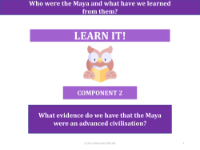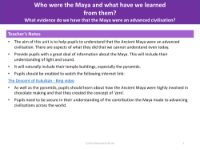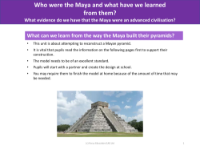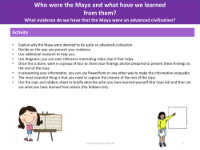Things we need to know about the Mayan civilisation - Info pack

History Resource Description
The Mayan civilisation, which thrived around 700 AD, was a dense and sophisticated society with estimates suggesting a population reaching between 10 to 15 million people. Cities like Chichen Itza and Tikal were bustling hubs, with Tikal possibly housing up to 60,000 inhabitants. The Mayans were advanced in their understanding of astronomy, as evidenced by the temple of Kukulcan. This architectural marvel was designed to align with celestial events, such as equinoxes, during which a serpent-like shadow can be seen slithering down its staircase. Despite being a subject of study for decades, the Mayan civilisation still holds many secrets, with unanswered questions about their origins and the decline of their empire. Their lasting legacy includes monumental architecture, unique cuisine, and influential languages that have shaped our modern world.
The Maya were also innovative in their culinary practices, creating foods that remain popular today. They were the first to roast cacao seeds for hot chocolate, a sacred drink used in religious ceremonies and even as a form of currency. Their version was quite different from our contemporary chocolate, as it lacked sugar and milk, which were later additions by the Spaniards. Furthermore, the Maya utilised natural resources to enhance their sacred buildings. During an analysis in 2008, scientists discovered that a temple in Honduras was coated with mica, creating a glittering effect in the sunlight. Their pyramids also reflected their astronomical knowledge, with the Chichen Itza pyramid designed to mark celestial events like the summer and winter solstices. Additionally, the Maya independently developed the concept of zero, represented by a shell-shaped glyph, and built a thriving civilisation in the challenging environment of a rainforest, showcasing their remarkable adaptability and ingenuity.





